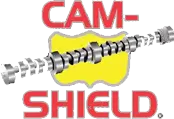Why NOT diesel or racing oil?
Contrary to the current internet buzz that diesel oil is the oil to use in a gasoline flat tappet cam engine, the correct oil to use on a continuous basis in your classic car’s flat tappet cam engine is an oil designed for gasoline engines that contains the correct level of ZDDP anti-wear protection. Similarly, a race oil is not recommended for continued use in a street driven gasoline engine.
If you look on the back of a bottle of oil you will see the API performance classification for the oil. Diesel oils with API credentials of CI-4, CI-4 Plus, CJ-4 will typically have Zinc levels around 1100 parts per million (ppm). For a flat tappet cam gasoline engine with moderate valve spring pressures (such as a flat head engine) the generally accepted minimum level of protection is 1200 to 1300 ppm of Zinc. For muscle cars and hot rods with higher valve spring pressures, 1600 ppm will give uncompromised protection. Race cars generally need around 2000 ppm. Break-in of a new cam is generally best protected with around 2500 ppm (in addition to the molybdenum cam lobe lube). Current API SM/ILSAC GF-4 gasoline engine oils have incredible performance capabilities and will have approximately 850 ppm of Zinc, but will need to be supplemented with ZDDP to make them suitable for use in flat tappet cam engines in classic cars, hot rods and race cars. It is extremely important to add a highly concentrated ZDDP product so as not to dilute the oil and thus impact the performance integrity of the engine oil.
Here are the differences between diesel engine oil and gasoline engine oil. In a modern diesel engine there is substantial exhaust soot contamination that the engine oil must contend with. Diesel oil is designed with much higher levels of detergency and dispersency to fight the soot contamination. Like ZDDP anti-wear chemistry, detergents are a surface active chemistry and compete directly for space on metal surfaces, such as the cam lobe and lifter face. So, in practice, the effective level of Zinc anti-wear is a bit lower than what we expect it to be based solely on chemical analysis. Additionally, the ZDDP that is generally used in diesel formulas is primary ZDDP (which activates at higher engine temperatures) since a diesel engine runs predominantly at operating temperature. In a gasoline engine, we must have both primary and secondary ZDDP (which activates at lower temperatures) since the engine will experience a significant number of cold starts. Also, the viscosity modifier polymers that are used in multi-viscosity engine oil to prevent viscosity loss at operating temperature (to protect the bearings) are different for diesel oil and gasoline oil. Diesels operate at essentially the same rpm all day long and need polymers that are shear stable to protect the bearings. Gasoline engines experience many large ranges of rpm during operation and require polymers that have both shear stability and thickening efficiency capability to protect the bearings.
Race oil formulas are typically designed with reduced levels of detergency and dispersency to improve performance of the anti-wear and friction modifier chemistries. Race oil is typically changed very frequently and race engines are typically re-built frequently. For a street driven gasoline engine, the correct levels of detergency and dispersency are required to prevent deposit formation (particularly at the piston rings), and sludge formation, from contaminants. This becomes more important to classic car owners who may only drive the vehicle occasionally and who change the oil once or twice a year.
|
